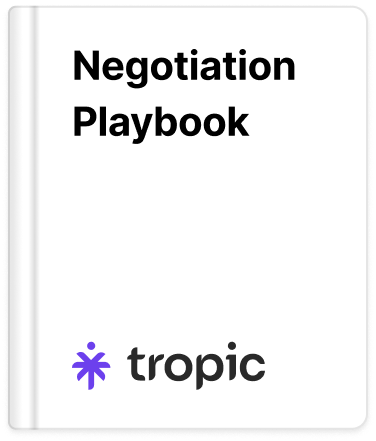
Retool Pricing Negotiation Guide for Procurement and Finance Teams

Pricing Overview
Retool offers a tiered pricing model with plans based on features and user needs. There's a free tier for basic functionality, and paid plans that provide advanced features, more users, and premium support. Pricing scales according to the number of users, data sources, and additional capabilities required, such as enterprise-level security and support.
- Team:
- 5,000 Workflow Runs/Month
- Staging Environment
- >5 Users
- Business:
- Everything in Team
- Audit Logging
- Rich Permission Controls
- Portals and embedded apps
- Unlimited environments
- Unlimited modules
- Access to external user pricing
- Enterprise:
- Everything in Enterprise
- SAML/SSO
- Source Control
- Custom Branding
- Independent Workspaces
- Volume Discounts
- Dedicated Spport
General Strategy
1. Leverage Budgetary Constraints and Competitors
- Highlight Budget Limitations: Use your organization's budget constraints as a negotiation tool to push for a reduced annual total.
- Mention Competitors: When negotiating, mention competitors to make Retool more flexible, especially on their Enterprise plan.
2. Pricing and Discount Strategies
- Enterprise Tier Discounts: Only the Enterprise tier allows for discounting. Use this to your advantage if your organization qualifies.
- Long-term Agreements: Retool often applies a 5%-10% discount on long-term agreements. A two-year term can result in a discount in the range of 7-10%.
- Early Renewal Incentives: Retool incentivizes early renewals by offering reduced renewal costs and credits for any unused time on the existing term.
3. Contract Terms and Billing Options
- Avoid Arbitrary Renewal Uplifts: Sign quickly and enforce the lack of approvals on arbitrary renewal uplifts to waive those fees. -
- Monthly vs. Annual Billing: Retool offers both monthly and annual billing. They incentivize annual billing with a 20% discount on the Team and Business plan.
- Semi-Annual Billing: Semi-annual billing is achievable, especially under the Business tier pricing.
4. New Pricing Models and Structures
- Leverage New Pricing Models: Retool's new pricing structure can reduce costs compared to previous contracts without changing volume or functionality.
- Standard and End Users: If the new pricing model is higher than the existing spend, leverage continued growth and a multi-year agreement to achieve the same or better price as the legacy plan.
5. Volume and Growth Incentives
- Volume Incentives: Retool will incentivize volume early on and potentially apply growth tiers to help with future growth.
- Strategic Plans for Future Use: Retool may form strategic plans to get introduced to new teams within your organization, which can be used as leverage in negotiations.
Custom Strategies
Custom Strategy #1: For Renewals
1. Review Current Usage and Budget Constraints
- Take a Look at Current Usage: Check how you’ve been using the service and see if there are any changes in your needs since the last renewal. This includes looking at user numbers, data sources, and any new requirements.
- Confirm Budget Limits: Reconfirm your budget for the renewal period and use it as a negotiating tool. Be upfront about any budget constraints to help Retool offer more flexibility.
2. Leverage Previous Contract Insights and Competitors
- Evaluate Past Contracts: Review the terms from your previous contract and see where you might negotiate better conditions based on your history. Point out any areas where you may have been over-committed or had underused features.
- Mention Competitors: Bring up what competitors are offering in terms of pricing and features. This can help you negotiate better terms or discounts by creating some competitive pressure.
3. Negotiate Renewal Terms and Discounts
- Explore Discount Opportunities: Ask about any available discounts for your renewal, especially if you’re moving to the Enterprise tier. Look into long-term renewal discounts (usually 7-10% for multi-year commitments) and any incentives for renewing early.
- Request Adjustments: If your needs or usage have changed, ask for adjustments or extra perks based on the new situation, such as credits for unused time or additional features.
4. Optimize Contract and Billing Options
- Review Billing Cycles: Consider the different billing options available. If you can, choose annual billing to take advantage of potential discounts (like 20% off) and avoid more frequent billing.
- Finalize Contract Terms: Make sure all the negotiated terms are clearly laid out in the renewal contract. Double-check that there are no surprise renewal increases and that the final terms fit your organization’s needs.
5. Tie an early signature date to any pricing concessions
- Be clear with your ask and highlight that you can sign by X date, in exchange for X annual price or discount.
Custom Strategy #2: For New Purchases
1. Gather Comprehensive Data and Assess Needs
- Understand Your Requirements: Clearly define what your organization needs, like the number of users, necessary features, and data sources. This will help you focus your negotiation on what's truly important.
- Collect Competitive Quotes: Get quotes from competitors to understand the market pricing and features. This will give you leverage and a benchmark when negotiating with Retool.
2. Leverage Competitive Insights
- Highlight Competitor Offers: Use information about competitors’ pricing and features to create leverage. Emphasize any advantageous terms or discounts competitors offer to push Retool for a more competitive deal.
- Negotiate Based on Market Data: Share market data and competitive quotes with Retool to show how their pricing stacks up. This can help you secure better terms or additional concessions.
3. Negotiate Pricing and Contract Terms
- Explore Discount Opportunities: Negotiate for discounts based on the scale of your purchase, especially if you’re looking at the Enterprise tier or a long-term agreement. Ask about any available discounts or incentives for new purchases.
- Request Concessions and Add-ons: Ask for additional benefits or concessions in the contract, like extra features, free trials, or early-bird incentives.
4. Finalize Billing and Contract Details
- Evaluate Billing Options: Look at the different billing options available, like annual or semi-annual billing. Choose annual billing if it offers a discount and fits your budget.
- Ensure Clear Contract Terms: Carefully review all contract terms before finalizing. Make sure there are no hidden costs or unexpected renewal increases, and confirm that all negotiated terms are clearly documented.
5. Tie a signature date to any pricing concessions
- Be clear with your ask and highlight that you can sign by X date, in exchange for X annual price or discount.
Custom Strategy #3: When the Pricing Model changes (increases price for similar features)1. Assess the Value and Impact of Legacy vs. New Pricing Models
- Evaluate Legacy Pricing Benefits: Understand and document the benefits and value of your current legacy pricing model. Highlight how it meets your needs and any cost advantages it provides.
- Analyze New Model Costs: Review the new pricing model carefully to see how it stacks up against the legacy model. Consider the impact on your budget and overall cost-effectiveness.
2. Leverage Competitive Quotes and Market Data
- Gather Competitive Quotes: Get quotes from competitors for similar features and functionalities. Use this data to show that the new model’s pricing is less competitive compared to other options in the market.
- Highlight Market Trends: Present market data that shows competitive pricing for similar tools. This can reinforce your position and push Retool to offer a more favorable transition deal.
3. Negotiate Transition Terms and Discounts
- Request a Transition Discount: Ask for a discount or special pricing to make the move from the legacy model to the new model more manageable. Emphasize the cost burden and request a transition incentive.
- Seek Additional Concessions: Ask for extra benefits or concessions, like free training, extended trial periods, or additional features, to offset the higher cost of the new model.
4. Ensure Contract Flexibility and Review Terms
- Request Contract Flexibility: Negotiate for flexible contract terms, such as a trial period for the new model or an opt-out clause if the new pricing doesn’t meet your needs.
- Review and Document Terms: Make sure all the terms of the new model are clearly documented and reviewed. Confirm that there are no hidden costs or unfavorable clauses, and that the agreement reflects all negotiated concessions.
5. Tie a signature date to any pricing concessions
- Be clear with your ask and highlight that you can sign by X date, in exchange for X annual price or discount.




